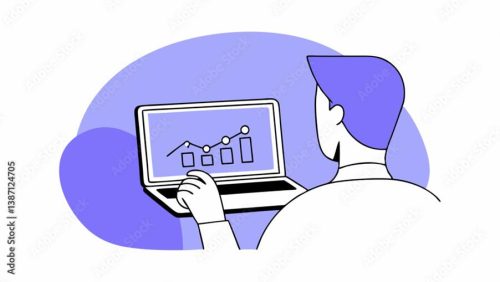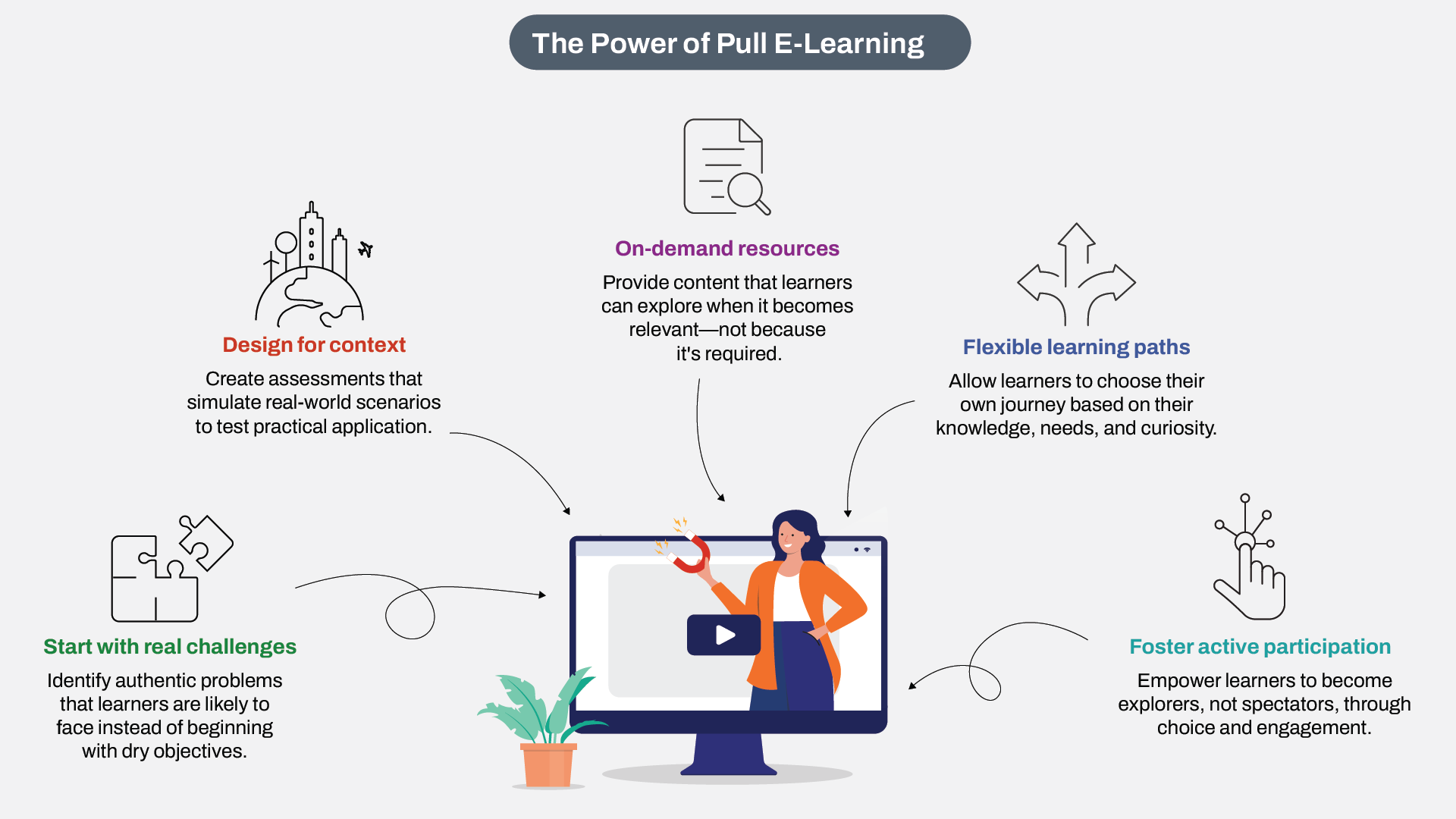On the planet of e-learning improvement, we regularly discover ourselves caught in a cushty however limiting sample. We meticulously collect content material, manage it into logical sections, add some data checks, end with a quiz, and name it a day. However what if this conventional method is definitely hindering true engagement and studying switch? What if there’s a wiser option to design e-learning experiences that genuinely resonate with learners?
The “Push” Drawback
Let’s face it: most e-learning programs comply with a predictable system. You’ve seen it numerous instances – aims at the start, content material within the center, quiz on the finish. This method is what we’d name a “push” technique – we’re primarily pushing info at learners, hoping a few of it sticks.

This factory-like mannequin assumes all learners want the identical info introduced in the identical manner. Certain, in case your solely objective is checking compliance packing containers or monitoring completion charges, this method works effective. However in case you’re aiming for precise conduct change or significant ability improvement, merely pushing content material isn’t sufficient.
The Energy of the “Pull”
What if we designed programs not round content material supply however round creating conditions the place learners actively hunt down info? That is the essence of the “pull” method – structuring studying experiences the place info is accessed when wanted, not when prescribed.
With a pull-based design, you continue to present all the mandatory content material, however you modify how learners entry it. As an alternative of force-feeding info, you create eventualities, issues, or actions that encourage learners to hunt out options.

Actual-World Studying Is “Pull-Based mostly”
Take into consideration the way you be taught in actual life. When was the final time you learn an instruction handbook cowl to cowl earlier than making an attempt one thing new? Extra seemingly, you jumped in and consulted assets solely if you hit roadblocks.
Contemplate this instance from the house enchancment world: assembling furnishings. When going through the problem of placing collectively a brand new bookshelf, you don’t need to learn an encyclopedia on furnishings historical past and varieties. You want particular steering on connecting the appropriate items proper now.
In case you had taken a course on furnishings meeting beforehand, would you keep in mind the precise process months later? Most likely not. However when confronted with an actual drawback—costly furnishings items doubtlessly being broken on account of incorrect meeting—you’re all of a sudden motivated to search out and keep in mind the answer.
That’s the ability of pull-based studying – info turns into related precisely when wanted.
Making the Shift: From Push to Pull
Transitioning to pull-based e-learning doesn’t imply throwing out your present content material. It means restructuring how learners encounter and interact with that content material. Right here’s the best way to st
-
Start with Challenges, Not Content material
As an alternative of organizing your course round content material subjects, manage it round challenges or issues your learners would really face. Ask your self: “What conditions would require my learners to make use of this info?”
Instance: Quite than making a module titled ‘Buyer Service Rules,’ begin with a problem like ‘Dealing with an Offended Buyer’ the place learners should navigate a troublesome dialog, pulling in ideas as wanted.
-
Create Significant Context
Develop eventualities, case research, or simulations that mirror real-world conditions. These don’t should be elaborate or costly – even easy text-based eventualities can successfully create the necessity to entry info.
Instance: For a compliance course, as a substitute of itemizing laws, current a situation the place an worker wants to find out if a selected motion violates firm coverage, encouraging them to seek the advice of the related tips.
-
Make Data Accessible, Not Obligatory
Construction your content material as assets that help problem-solving fairly than as obligatory studying. Permit learners to entry what they want wh
Instance: In a gross sales coaching course, present a library of product info sheets that salespeople can seek the advice of throughout role-play eventualities when clients ask particular questions, fairly than forcing memorization of all product particulars upfront.
-
Embrace A number of Paths
Settle for that totally different learners might take totally different routes via your content material primarily based on their prior data and particular wants. This isn’t a flaw – it’s personalised studying in motion.
Instance: In a management improvement program, permit skilled managers to skip primary communication workouts whereas newer leaders may spend extra time on these fundamentals, with each teams converging for superior battle decision eventualities.
-
Deal with Utility Over Acquisition
Design actions the place success relies on making use of info appropriately, not simply memorizing it. This creates real motivation to know content material deeply.
Instance: As an alternative of quizzing learners on the steps of mission administration, have them plan a simulated mission the place they need to apply planning ideas to keep away from finances overruns and missed deadlines.
The Outcomes: Studying That Sticks
When learners pull info to resolve issues:
- Retention improves as a result of info is linked to significant contexts
- Engagement will increase as learners develop into lively individuals
- Switch to the office occurs extra naturally
- Studying turns into personalised to particular person wants and data gaps
A pull-based e-learning course may take a bit extra thought to design initially, however the payoff in precise studying outcomes is well worth the funding.
Your Subsequent Course: Push or Pull?
As you propose your subsequent e-learning mission, problem your self to assume in another way. As an alternative of asking “How can I manage all this info?” ask “How can I create conditions the place learners will hunt down this info?”
By specializing in creating the pull, you’ll design programs that work the best way the human mind naturally works – connecting info to wants, issues, and real-world purposes.
Cease pushing. Begin pulling. Your learners (and their efficiency outcomes) will thanks.


